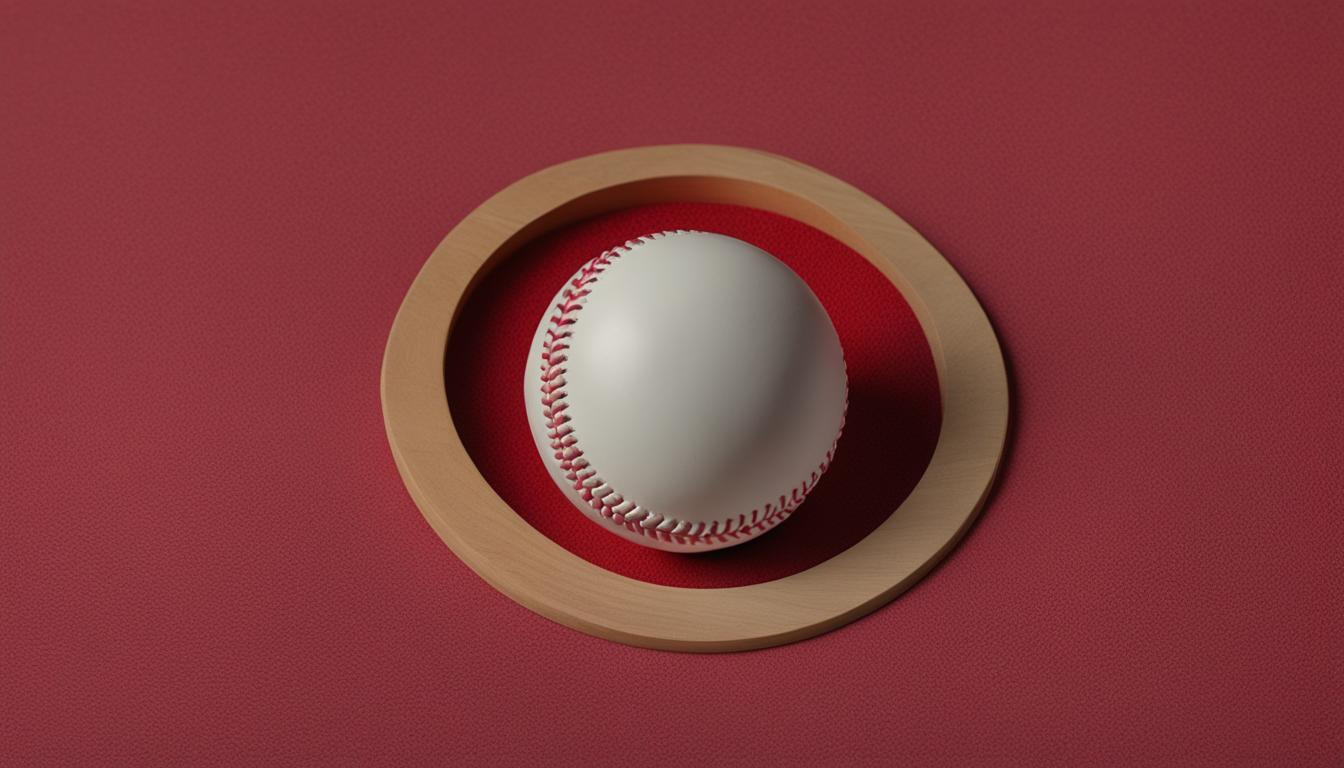As a sports enthusiast, I find the comparison between a cricket ball and a baseball ball fascinating. Both of these sports involve the basic principle where one team aims to score runs with the ball while the opposing team seeks to prevent this and dismiss the players. Interestingly, while the cricket ball and baseball ball might appear similar at first glance, their size, weight, design, and impact on gameplay reveal critical distinctions that shape each sport uniquely.
The cricket ball is traditionally heavier and has a more pronounced seam, influencing its aerodynamics and how it behaves upon pitching. Likewise, the baseball ball, slightly lighter and smaller, is designed to be pitched with a variety of grips, giving rise to an array of pitches – each with its own speed and movement. Hence, understanding these differences is not just a point of curiosity; it significantly contributes to the strategies and excitement inherent in both games.
Key Takeaways
- The size and weight variations between a cricket ball and a baseball ball affect how each is used in gameplay.
- A cricket ball’s design, with its pronounced seam, can influence how it moves in the air and off the pitch.
- The leather covering and construction of both balls denote traditional craftsmanship tailored to each sport’s needs.
- Understanding the distinctions in equipment aids fans and players in appreciating the nuances and strategies involved in cricket and baseball.
- A deeper look into the cricket ball vs baseball ball debate opens a window into the wider contrasts and cultural significance that these sports hold globally.
The Genesis of the Game: Tracing the Origins
The evolution of modern sports is as fascinating as the games themselves. Both cricket and baseball, classic bat-and-ball games, have rich histories that reflect broader cultural shifts.
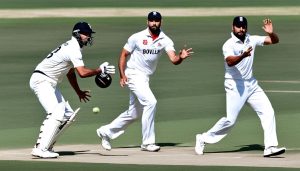
Let’s delve into the past to understand how the cricket ball and the baseball ball came to be icons within these revered sports.
Cricket: A Rich History Dating Back to the 16th Century
Cricket’s inception can be traced back to the verdant fields of 16th-century England. This game, which I now see played in every corner of the globe, has transcended its humble origins to become a symbol of international competition and camaraderie. With its first international match in 1844 and the inauguration of official Test cricket in 1877, cricket history is as complex as it is long-standing. The first Cricket World Cup in 1975 was a emblematic moment, showcasing the game’s leap from an English pastime to a sporting event with a global footprint.
Baseball: America’s Evolution of Ancient Bat-and-Ball Games
Baseball’s tapestry is interwoven with threads of America’s own history, notably evolving during the Civil War in the 19th century. What began as folk games from the British Isles was transformed on American soil, adapting to new surroundings and societal changes. This evolution—a stirring tale of baseball’s journey—is what shapes my understanding of this game, how each crack of the bat echoes the cultural narrative of America itself.
Understanding the intricacies of cricket and baseball requires appreciation for their respective origins. These sports did not merely emerge; they were born out of the fabric of societies, tailored by necessity, and refined through generations of play. Here is a comparative look into the early days of these games:
| Century | Cricket | Baseball |
|---|---|---|
| 16th | Originated in England | Roots in British Isles’ games |
| 19th | International play established | Modern rules standardized in America |
| 20th | First Cricket World Cup (1975) | America’s favorite pastime, with global leagues emerging |
As I reflect on cricket’s transformation from England’s legacy to an international sensation and baseball’s transition from pastime to professional spectacle, it’s evident that both games share not only a common ancestry but a history rich in development and innovation.
Understanding the Playing Field: Dimensions and Dynamics
The definitive aspects of both cricket and baseball are not only found in the way the ball is pitched or hit but also in the very ground it’s played upon. The cricket pitch and the baseball field each hold unique characteristics that markedly affect gameplay and strategy. Let’s delve into the nuances of these playing surfaces, understanding the exact field dimensions and what constitutes the outfield in both sports.
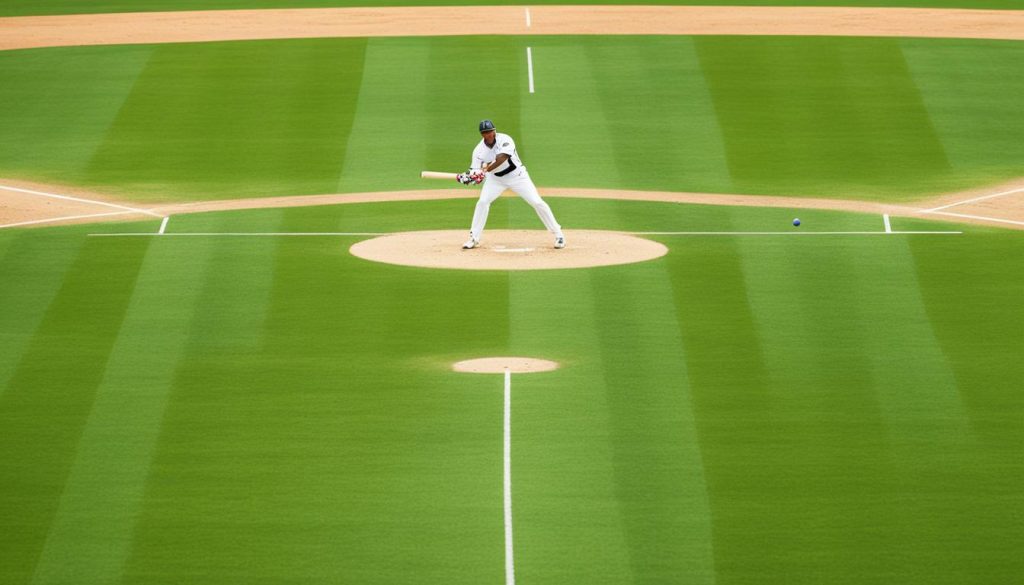
Cricket: The 22 Yard Pitch and Oval Field
Central to the game of cricket lies the 22-yard pitch—a flat, rectangular area that is the heartbeat of the game. This pitch is where bowlers unleash their deliveries and where batsmen craft their strokes. The oval shape of the cricket field encloses the pitch, forming a boundary that determines the scoring for hits.
Baseball: The Diamond Shape and Recommended Field Distances
In contrast to cricket’s broad expanse, a baseball field is formed into a precise diamond, where every base and the home plate create a strategic framework for the players. The infield and outfield blend seamlessly, shaped by foul lines that extend into the horizon, creating a distinctive play area.
| Aspect | Cricket | Baseball |
|---|---|---|
| Shape of Field | Oval | Diamond |
| Size of Pitch/Area | 22 yards (Pitch) | 90 feet between bases (Infield) |
| Boundary/Outfield Dimensions | Variable, usually 150-200 feet from pitch to boundary | Minimum 325 feet (Foul Lines), 400 feet (Center Field) |
| Dynamics of the Area | The longer pitch favors varied bowling and running strategies | The tighter diamond shape emphasizes swift, reactionary gameplay |
As I explore the intricacies of these fields, it becomes clear that the very layout dictates how the games are played. While viewers might revel in the towering sixes of cricket or the home runs of baseball, those familiar with the sports understand how these electrifying moments are shaped by the sunbaked cricket pitch and the meticulously groomed baseball field. The dimensions and dynamics of each, from the compact baseball diamond to cricket’s expansive outfield, are integral in making each sport a thrilling spectacle.
Anatomy of the Balls: Cricket Ball vs Baseball Ball
Discussing the cricket ball vs baseball ball, one must take a deep dive into the leather covering and ball construction that set them apart. The cricket ball, synonymous with tradition, boasts a significantly heavier leather exterior. This denser leather covering contributes to the cricket ball’s reputation for durability and longevity throughout the prolonged periods of match play. On the contrary, the baseball’s leather is stitched snugly around the ball, giving it a smooth, consistent surface that pitchers can grip and manipulate for various pitches.
| Attribute | Cricket Ball | Baseball Ball |
|---|---|---|
| Weight | 5.5 to 5.75 ounces | 5 to 5.25 ounces |
| Construction | Layered with cork and wool | Cork, rubber, and yarn |
| Exterior | Heavy leather, stitched | Tight leather, stitched |
| Usage in Gameplay | Bounce and swing | Throwing variations |
The core of a cricket ball is intricately layered with cork and wrapped in tightly wound string, then encased in a high-quality leather shell that is meticulously stitched together. As for the baseball ball, its makeup comprises a cork or rubber center, wrapped in yarn, and finally, the leather covering that we see when it takes flight across the diamond.
The construction of these balls isn’t just for the crisp crack off a bat or the satisfying thud into a glove; it shapes the way the games are played. The cricket ball remains a key component in both bowling and batting strategy, heavily influencing the sport’s dynamic pace and skill set. Equally, baseball’s precise dimensions lend themselves to a pitcher’s arsenal – enabling an array of pitches from curveballs to sliders – that captivate fans through a ballet of aerodynamic movement.
I find that while both sports cherish the sphere that sits at their core, the subtle differences in their balls’ construction speak volumes about their distinct identities. From the leather to the core materials, every element serves a purpose built by history and honed by the hands of athletes.
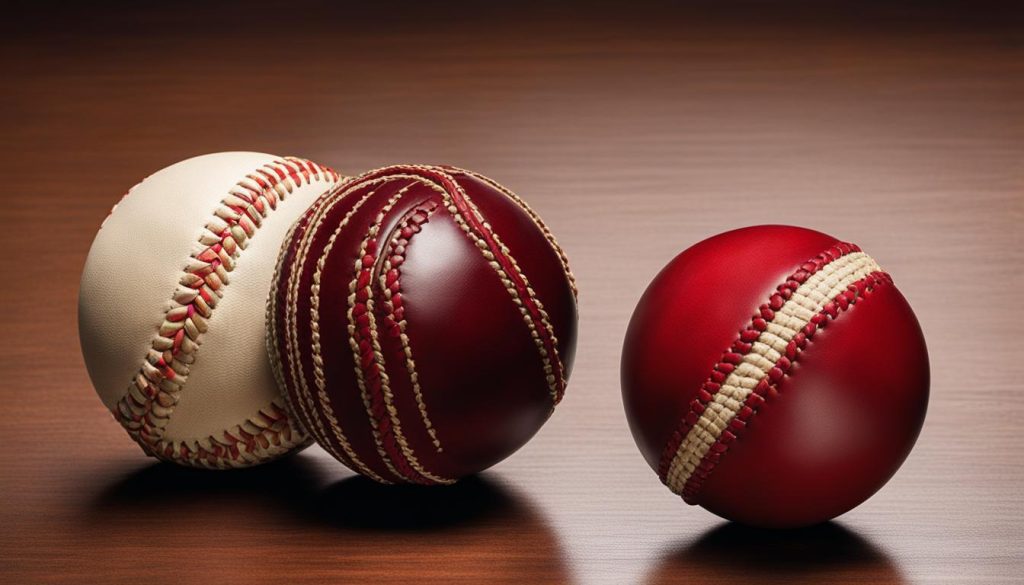
Scoring and Gameplay: A Comparative Analysis
When delving into the technical nuances that differentiate the cricket ball vs baseball ball, a key element that emerges is the method of scoring runs. Despite both sports circling around the central aim to amass runs, the execution diverges sharply. In cricket, I can garner runs via a strategic mix: sprinting between the wickets or capitalizing on the game’s boundary rules to score ‘fours’ and ‘sixes’. Meanwhile, in baseball, the crux of scoring rests on navigating the diamond to accumulate runs or hitting home runs.
Let’s break down the scoring types based on the phase of play. With cricket’s versatility on display through its formats – Test Matches, One Day Internationals, and Twenty20 – each presents a unique rhythm affecting how I strategize scoring. Baseball, contrastingly, splits its game structure into a fixed count of innings, totaling nine, offering a structured pace within which teams push to score optimally.
I’ve observed that understanding these dynamics creates a rich tapestry of sporting culture. To further emphasize the distinctions in a visually engaging format, consider the following comparative table:
| Aspect | Cricket | Baseball |
|---|---|---|
| Primary Scoring Method | Running between wickets, Hitting boundaries | Circling bases, Home runs |
| Game Formats | Test, ODI, T20 | 9 Innings |
| Run Value | 1 run per wicket cross, 4/6 for boundaries | 1 run per base circuit |
| Inning Structure | Variable for each format | Fixed 9 innings |
Achieving mastery over these aspects can enable fans and players alike to move beyond the rudimentary cricket ball vs baseball ball comparisons and into an in-depth appreciation for both games. From intricacies of boundary rules to the steadfast duration of innings, the journey through these sporting landscapes is as thrilling as it is enlightening.
The Mechanics of Delivering the Ball: Bowling vs Pitching
When comparing the precision arts of cricket bowling and baseball pitching, the distinctions go beyond mere technique—they encompass the foundational gameplay strategies that shape each sport’s character. In exploring the cricket ball vs baseball ball dynamic, one can’t help but delve into the skill sets and mindsets required for mastery in each.
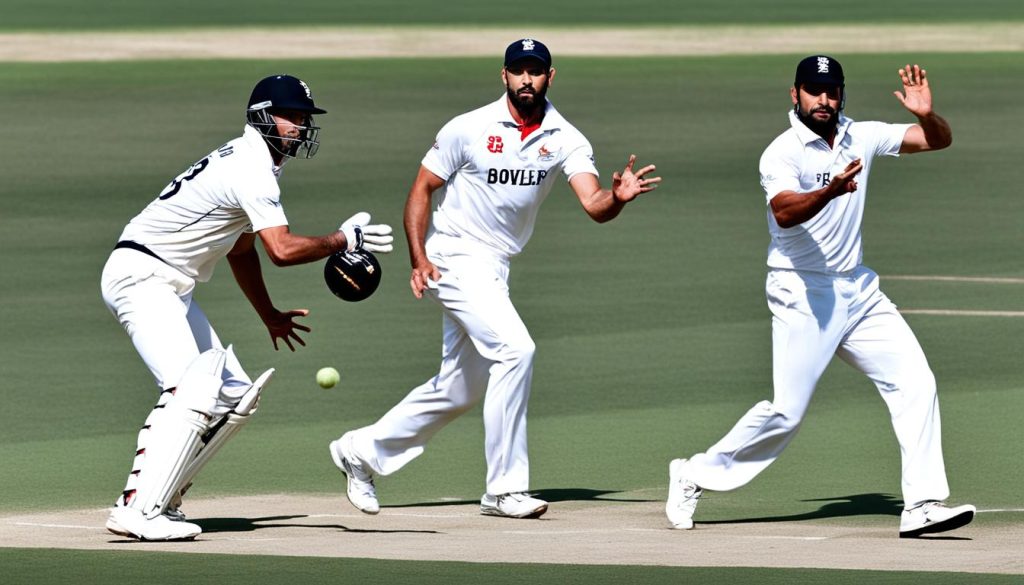
Styles and Strategies in Cricket Bowling
Cricket bowlers have an arsenal of bowling styles at their disposal, each with unique grip techniques and biomechanical execution. Seamers generate pace and bounce, while spinners focus on using the wrist or fingers to impart spin, deceiving the batsman. Fast bowlers aim to overwhelm with speed, juxtaposed by the guile of the slow bowlers. The astute cricket aficionado discerns the nuance between leg-spin, off-spin, and the revered doosra or googly, each bowling style necessitating distinct cricket balls tailored to the bowler’s intentions.
Baseball Pitching: The Role of the Hands and Game Structure
Baseball pitchers, in contrast, serve up an array of pitches dictated by grip, wrist action, and arm speed—curves, sliders, fastballs, changeups—a lexicon familiar to the baseball connoisseur. The diversity of pitching roles in baseball, from starting pitchers to relievers and closers, underscores a complex game structure. Each role is critical, with the starting pitcher often seen as the linchpin of the team, setting the tone for the game.
In my analysis, both sports demand dexterity and acute mental acuity. While bowling styles and pitching roles diverge in function and form, the essence remains the same: outwitting the opponent by mastering the spherical craft. It is this chess match—the pitcher or bowler versus the batter—that captivates audiences and solidifies the timeless allure of cricket and baseball.
International Appeal and Cultural Impact
As a professional copywriting journalist who’s explored diverse sporting cultures, I’ve witnessed firsthand how the dynamics between cricket ball vs baseball ball underpin distinctive international appeal and cultural significance. These two spheres of play resonate beyond their initial realms, influencing and shaping sports on a global stage.
Cricket: A Colonial Export Turned Global Passion
Cricket, with its roots firmly planted in English tradition, has blossomed into an international sensation. It’s fascinating to observe how countries that were once under British influence have kept hold of cricket, transforming it into an aspect of national pride and joy. The emergence of international cricket competitions, like the Cricket World Cup, showcases a remarkable amalgamation of cultures, where nations unite under the shared language of sport.
Baseball: America’s Pastime with Emerging International Roots
Meanwhile, baseball continues to uphold its storied legacy as America’s pastime. Despite its deep-rooted Americana, the influence of baseball has tip-toed across borders, embracing regions craving the crack of the bat. Baseball leagues in Japan, South Korea, and parts of Central America are burgeoning, exemplifying how a shared passion for the game creates a common thread among diverse cultures.
The sphere of influence both sports command serves as a testament to their cultural significance. While the cricket ball and baseball ball are mere sporting implements, they represent so much more: unity, identity, and the undying human spirit of competition.
Conclusion
As we’ve unraveled the intricacies of the cricket ball vs baseball ball, it’s evident that these elements are pivotal in defining the unique identity of both sports. While cricket and baseball share the inherent principle of scoring runs and their bat-and-ball lineage, the specialized equipment – namely the balls used – epitomizes the sporting contrast that distinguishes one game from the other. It’s not just about the size and the weight; it’s about how these specifications influence the swing of the bat, the flight of the ball, and the strategies that players worldwide have honed and perfected.
In my analysis of this gameplay comparison, I have identified that the diversity in ball design is more than a matter of material; it’s a reflection of the cultural and historic context from which each sport emerged and evolved. On one side, we have cricket, with a ball that has weathered the game’s transcontinental journey and now illuminates pitches from Sydney to Lords to Eden Gardens. On the other, a baseball that stitches together the seams of America’s culture, yet is also tossed across fields from Dominican Republic shores to the stadiums of Japan.
Ultimately, in contemplating the cricket ball vs baseball ball, we are not just comparing two sports equipment. We’re piecing together a mosaic of global sports heritage where every over and inning, every boundary and home run contributes to a larger story of human competition, collaboration, and celebration. This research journey has reaffirmed the consequence of delving into every facet of the games we love, underscoring the abiding legacies of both cricket and baseball as they continue to captivate hearts and compel rivalry across continents.
FAQ
What are the key differences between a cricket ball and a baseball ball?
The main differences lie in size, weight, and design. A cricket ball is heavier (5.5 to 5.75 ounces), has a larger circumference, and features a pronounced seam. A baseball, on the other hand, is slightly lighter (5 to 5.25 ounces) and has tighter stitching known as the “red stitch.” These differences significantly impact gameplay in both sports.
How does the history of cricket and baseball differ?
Cricket has a rich history dating back to the 16th century in England with professional international play beginning in 1844. Baseball evolved from ancient bat-and-ball games in the British Isles and took on its modern form in America around the time of the Civil War in the 1860s.
How do the dimensions of the playing field affect each game?
Cricket is played on a large oval field with a 22-yard-long central pitch, which allows for more varied angles of play and influences batting and fielding strategies. Baseball is played on a diamond-shaped quadrant with specific minimum field distances (325 feet down the lines and 400 feet to center) that create a tightly controlled playing area, affecting how the game is played strategically.
What is the importance of the leather covering in cricket and baseball?
The heavy leather covering of a cricket ball makes it harder and capable of achieving greater speeds and variations in swing and spin, which are crucial to the game’s strategy. In baseball, the leather covering ensures a firm grip and contributes to the ball’s aerodynamics, influencing the speed and curve of pitches.
How does scoring work in cricket compared to baseball?
In cricket, runs are scored by striking the ball and running between the wickets or hitting boundaries for four or six points. There are several formats of the game including Test Matches, ODIs (One Day Internationals), and T20s. Baseball involves scoring by rounding the bases to achieve runs, with the game divided into nine innings.
What are the differences between cricket bowling and baseball pitching?
Cricket bowlers utilize a variety of styles, such as fast, spin, and swing, and they alternate overs with other bowlers. In baseball, pitchers are often characterized by their throwing hand and role in the game, and they pitch throughout an entire inning before being substituted. The strategies and technical execution in both sports are quite distinct and integral to the game’s tactics.
How does the cultural significance of cricket compare with that of baseball?
Cricket has grown from its origins in England to become a global sport with immense popularity in former British colonies and international tournaments like the World Cup. Baseball, known as America’s pastime, has a profound cultural impact within the United States and has gained international traction, particularly in East Asia and Central America, with professional leagues in various countries.
Why is there a sporting contrast between cricket and baseball when both derive from bat-and-ball games?
Despite their common bat-and-ball game ancestry and shared objective of scoring runs, cricket and baseball have evolved into distinct sports due to differences in equipment, gameplay mechanics, and cultural context. Each sport reflects its history and the regions where it has developed, resulting in unique strategies, rules, and formats that define their respective identities.

